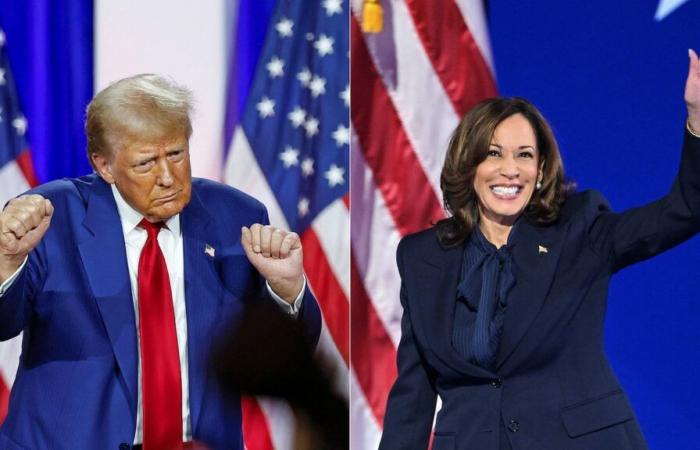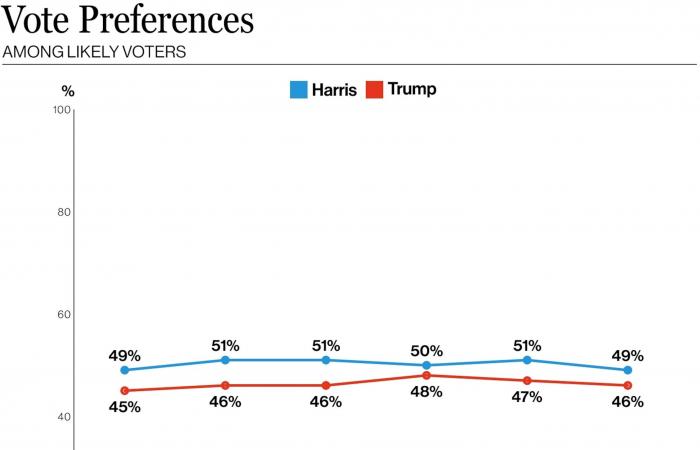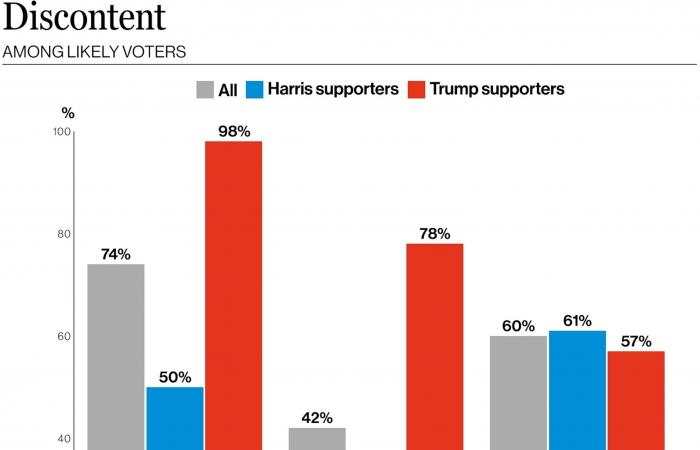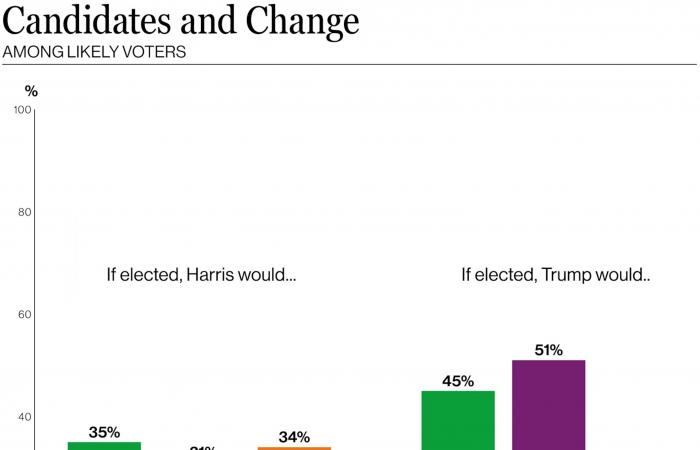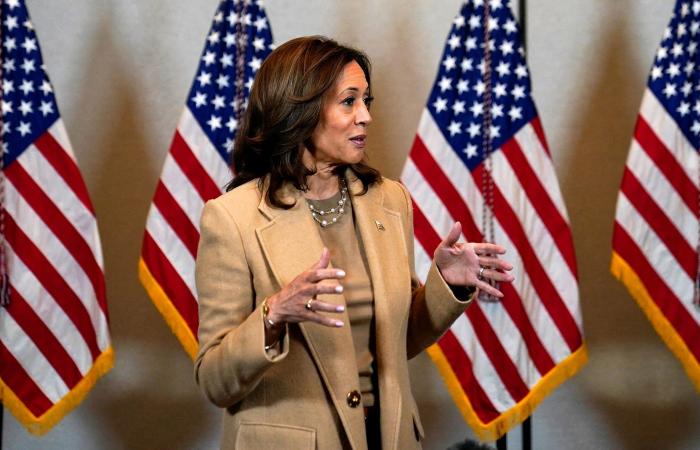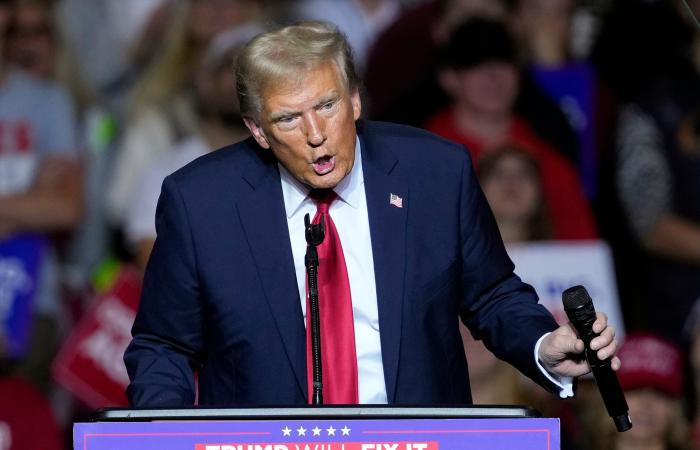A dispirited electorate marks the end of the 2024 presidential campaign, with three-quarters of likely voters saying the country is seriously off on the wrong track, six in 10 dissatisfied with their choice of candidates – and a tight race between Vice President Kamala Harris and former President Donald Trump.
Harris has 49% support among likely voters in this final-weekend ABC News/Ipsos poll, Trump 46%. Reflecting the country’s locked-in polarization, support for these candidates hasn’t changed significantly since Harris stepped in to replace Joe Biden last summer.
Former President and Republican presidential candidate Donald Trump dances as he leaves the stage of a town hall meeting in La Crosse, Wisconsin, Aug. 29, 2024. | Vice President and Democratic presidential candidate Kamala Harris arriving onstage to speak at the Democratic National Convention (DNC) in Chicago, Aug. 22, 2024.
Kamil Krzaczynskimandel Ngan/AFP via Getty Images
Harris was +2 in early October, +4 (a slight edge) last week and is +3 in this poll, produced for ABC by Langer Research Associates with fieldwork by Ipsos. That scant 3-point difference with Trump matches the average Democratic-Republican gap in the last eight presidential elections, of which Democrats won the popular vote in seven. Regardless, the result leaves a wide-open field for the vagaries of the Electoral College.
Vote Preferences among likely voters.
ABC News/Ipsos and ABC News/Washington Post/Ipsos polls
One dynamic behind these results is early voting. In data as of Friday morning, 38% said they’d already voted, and they went for Harris by 56-38%. That compares with 62-33% among early voters last week, and it’s closer in this group than the Democrats want.
See PDF for full results.
Not happy
Satisfaction with the contest, the economy and the country’s direction overall are in short supply. Seventy-four percent of likely voters say the country is headed seriously off on the wrong track – the most just before a presidential election since 2008. Half of Harris supporters say so, rising to nearly all, 98%, of Trump’s.
Dissatisfaction partly reflects economic attitudes. Forty-two percent of likely voters say they’re less well off financially than when Biden took office, vs. just 19% better off. The worse-off number has been at or near its highest in data since 1986 all year, reflecting the 40-year high in inflation experienced on Biden’s watch.
Here political divisions are especially profound, marking the connection between political views and economic ones. Seventy-eight percent of Trump supporters say they’ve become less well off under Biden. Among Harris supporters, just 8% go there.
On the other hand, in another measure – satisfaction with the choice of major-party candidates – partisans find a place to agree. Sixty percent are dissatisfied with the choice of Harris or Trump, including 61 % of Harris supporters and 57% of those backing Trump.
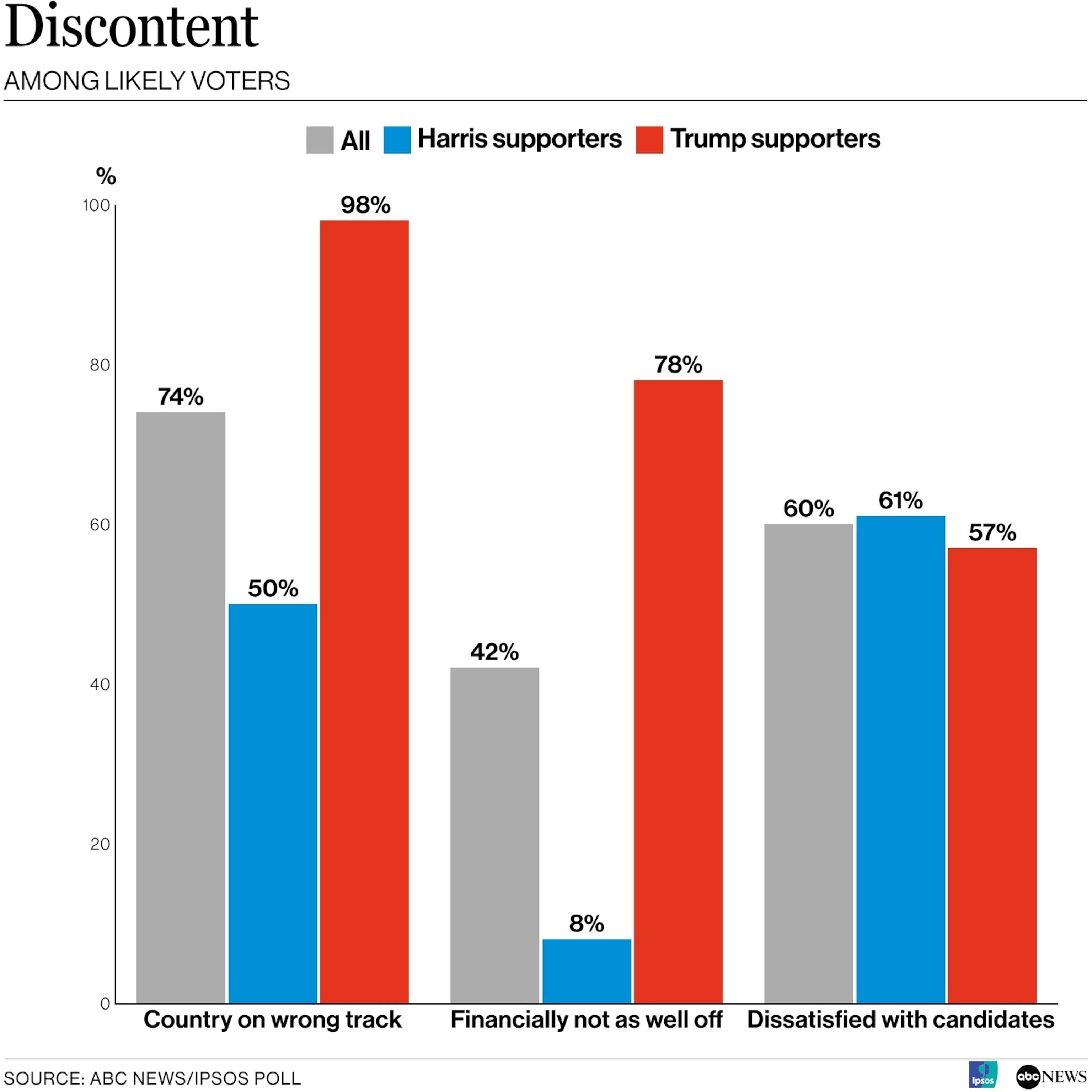
Discontent among likely voters.
ABC News/Ipsos poll
Good change/bad change
Dissatisfaction with the nation’s direction typically fuels support for change. That disadvantages Harris as she’s tried to differentiate herself from the Biden administration: Thirty-four percent of likely voters think that if elected she’d largely leave things as they are. Of the rest, 35% think she’d shake things up in a good way; 31%, in a bad way. (Among those who expect the status quo from Harris, the race is a tight 48-45%, Trump-Harris.)
In Trump’s case, by contrast, far fewer see him as holding to the status quo – just 4% say he’d leave things as they are. But more think he’d shake things up in a bad way, 51%, than in a good way, 45%.
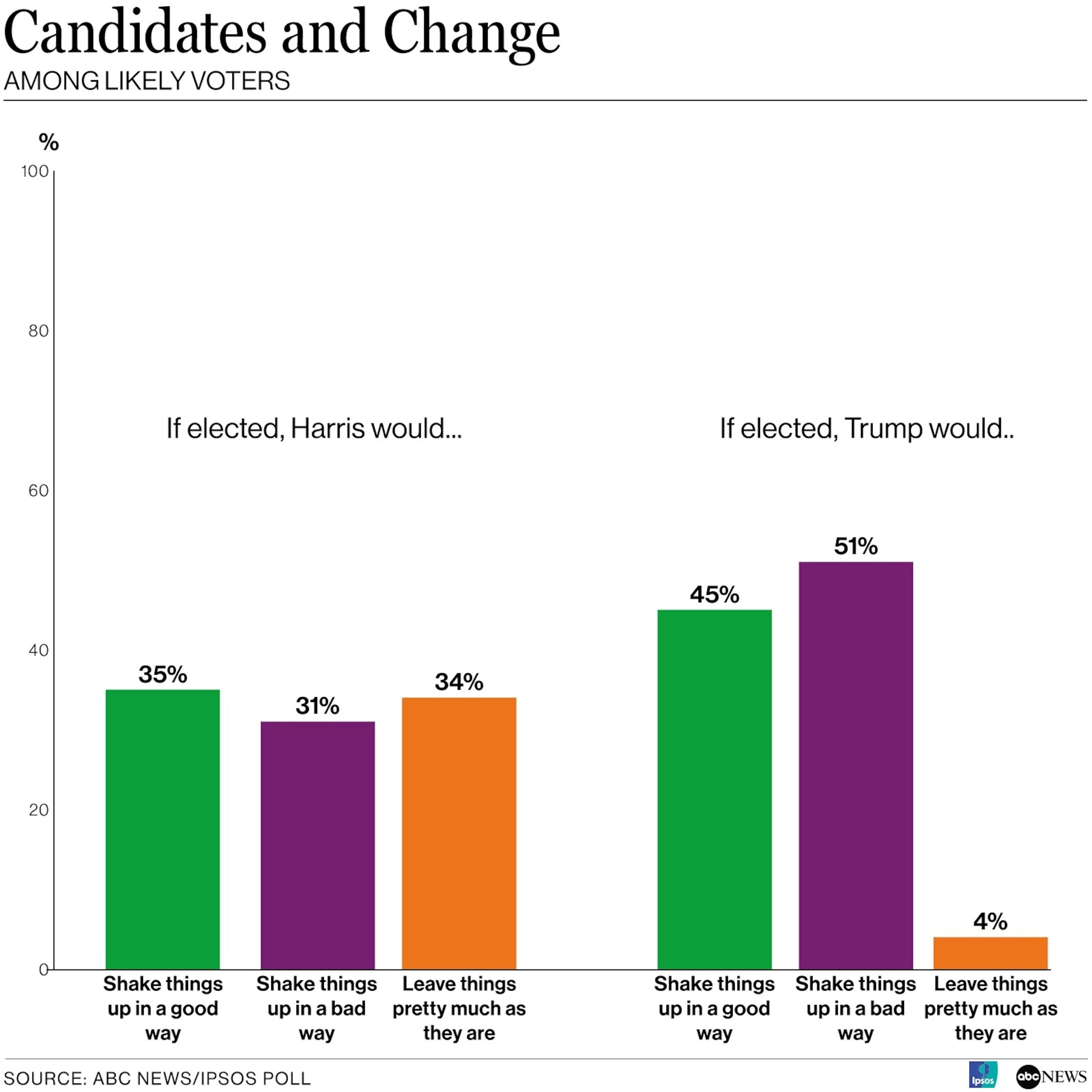
Candidates and Change among likely voters.
ABC News/Ipsos poll
Attributes
Harris scores better than Trump on personal favorability, and outpoints him, albeit by single digits, in having the personality and temperament it takes to serve effectively as president.
She gets an even split on favorability, 48-48% among likely voters. Trump’s much deeper in personal disfavor, seen favorably by 37%, unfavorably by 60%.
Another result eases the sting of unfavorability for Trump: Among likely voters who see both him and Harris unfavorably (13% of all likely voters), Trump leads widely in vote preference, 61-21%. (Among those who see only Trump unfavorably, not Harris, a minimal share – 2% – support him anyway. Among those who see only Harris unfavorably, none support her.)
On personality and temperament, 50% say Harris has what it takes to serve effectively, vs. 41% who say the same about Trump (these include the 4% who say both do); 12% say neither does. As with favorability, Trump pushes back against Harris’ advantage by leading, 50-25%, among those who say neither has the personality and temperament to serve effectively. Additionally, among those who think he doesn’t have the personality and temperament to serve effectively, 11% support him anyway. (Harris is supported by 6% of those who say she doesn’t have the right personality and temperament.)
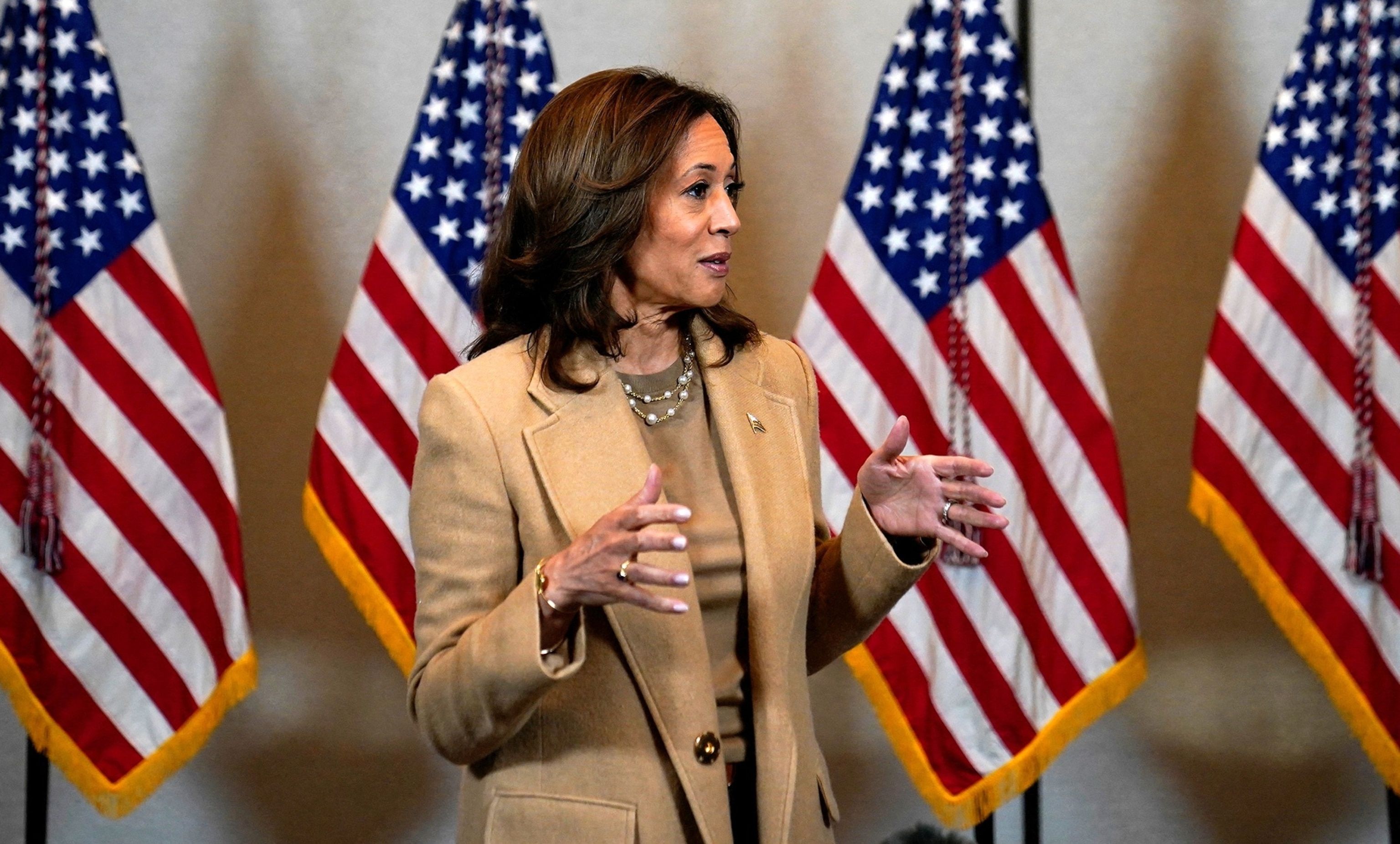
Democratic presidential nominee Vice President Kamala Harris speaks to members of the press in Milwaukee, Nov. 2, 2024.
Elizabeth Frantz/Reuters
Ground game
With a race so tight, the campaigns’ closing get-out-the-vote efforts may well make the difference. Here Harris maintains an advantage: Among all adults, 37% say they’ve been contacted by her campaign asking for their vote, vs. 33% by Trump’s. Among likely voters, that goes to 45 vs. 40%; and among likely voters in the seven battleground states, a slight 67 vs. 61% – a massive level of contact.
Moreover, Harris’ GOTV efforts look better targeted. Nationally, among likely voters who support her, 56% say they’ve been contacted by her campaign. Fewer Trump supporters, 49%, say his campaign has contacted them.
Groups
Estimates among Hispanic likely voters have been stable in three of the past four ABC/Ipsos polls, in mid-September, early October and this one, averaging 55-41%, Harris-Trump (54-39% in this poll). Last week’s 64-34% among Hispanic likely voters was different, although it approximated the result in the 2020 exit poll, 65-32%, Biden-Trump.
In any case, the latest result shows no ill-effect of a controversial joke by a comedian at a Trump rally last weekend. And it leaves open the question of where Hispanic voters land; outperforming in this usually more Democratic group would be a coup for Trump, nationally and especially in the battlegrounds of Arizona and Nevada.
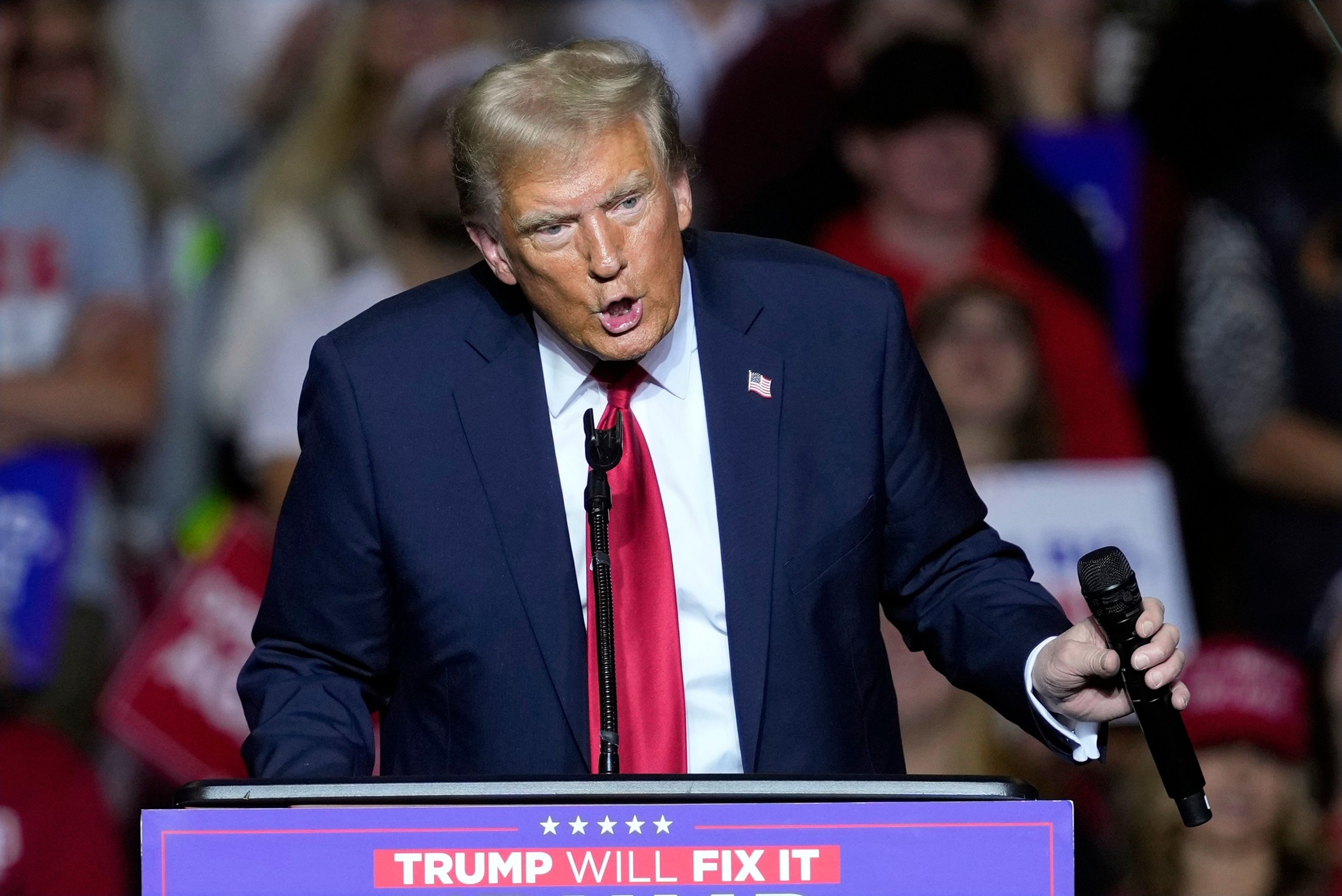
Republican presidential nominee former President Donald Trump speaks at a campaign rally on Nov. 1, 2024, in Milwaukee.
Morry Gash/AP
The closest contest among Hispanic voters in exit polls since 1976 was 58-40% in 2004; getting back to that, much less bettering it, would be a major outcome for the GOP, which has been sorely in need of support from racial and ethnic minority groups as they have grown in size.
Results are similar among Hispanic men and women, as has been the case previously. The shift from last week is especially large among younger Hispanic people, although the sample size is small.
Vote preferences among likely voters in other groups are similar to those in previous ABC News/Ipsos polls, allowing for sampling error, which is larger in smaller groups. Among them:
- Harris, who’s tried to attract disaffected Republicans, has 7% support in that group, while 3% of Democrats support Trump. Harris also wins support from 11% of conservatives, vs. Trump’s 4% among liberals.
- Independents – who’ve gone with the winner in nine of the last 12 presidential elections – are now +5 for Harris, 49-44%, although that’s not a significant difference. Harris leads by 55-37% among independent women, while it’s close, 49-45%, Trump-Harris, among independent men.
- Harris has support from 76% of Black men in these results (Biden won 79% of this group in 2020) and 87% of Black women.
- The race is close – a non-significant Trump +4 – among white women, 50-46%, a group he won by 11 points in 2020. A Democrat hasn’t won white women since 1996, though Al Gore came within a whisker in 2000. Trump leads by 13 points among white men, 54-41%.
- Harris has an especially wide lead among women age 18-29, 69-29%. That compares with a non-significant Trump +5 among men that age, 49-44%.
- Harris is maintaining a lead among suburban women, 55-40%, while the contest remains close among suburban men, 49-46%, Trump-Harris.
- The gender gap among all likely voters is 16 points – a non-significant Trump +5 among men, 50-45%, Harris +11 among women, 53-42%. That’s similar to where it’s been, as well as similar to the average (19 points) in exit polls since 1996.
- Trump has almost identical leads among non-college white men (63-33%) and non-college white women (62-33%) alike. Among all likely voters who don’t have at least a four-year degree, it’s Trump +11 points (53-42%); among college graduates, Harris +22 (59-37%).
- In a group that’s central to Republican prospects, Trump leads by 80-16% among white evangelical Protestants. Among all likely voters who are not white evangelical Protestants, it’s Harris over Trump, 55-40%.
- The seven battleground states, taken together, look like the nation: A 49-46%, Harris-Trump contest.
Results in this poll include the most prominent active minor-party candidates in states where they’re on the ballot. Among all likely voters, Libertarian Chase Oliver gets 1% support, Green Party candidate Jill Stein and independent Cornel West less than half a percent each and “someone else” 2%.
Methodology
This ABC News/Ipsos poll was conducted online via the probability-based Ipsos KnowledgePanel® Oct. 29-Nov. 1, 2024, in English and Spanish, among a random national sample of 3,140 adults, including 2,267 likely voters. Partisan divisions among all adults are 29-29-30%, Democrats-Republicans-independents, and 33-34-29% among likely voters.
Results have a margin of sampling errorof 2 percentage points, including the design effect, for the full sample and for likely voters, and 5 points for likely voters in the battleground states, Arizona, Georgia, Michigan, Nevada, North Carolina, Pennsylvania and Wisconsin. Sampling error is not the only source of differences in polls.
The survey was produced for ABC News by Langer Research Associates, with sampling and data collection by Ipsos. See details on ABC News survey methodology here.

